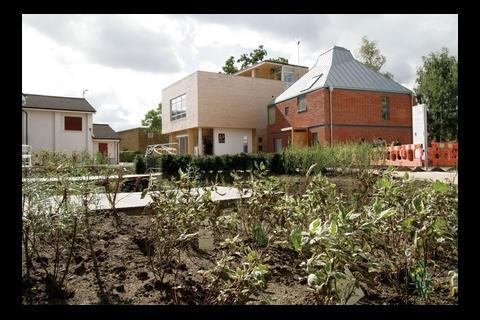In June a small community of ground-breaking experimental homes, plus a school, was unveiled at the BRE Innovation Park in Watford. That was just the start, as the articles in this special eight-page section reveal. Lessons are emerging for the industry on innovation and the move to zero carbon, and some of the ideas trialled are moving into the marketplace. Will Jones walks us through the park
The BRE Innovation Park in Watford is the first full-sized showcase for the best advances in house and school design. It’s already had a massive impact on those involved, but the work doesn’t stop here. “The plan is to have people living in the houses,” says Jaya Skandamoorthy, director of enterprise and innovation at BRE. “We’ll monitor the operation of the homes and perceptions of the users over the next two years so we can show the industry how best to build zero-carbon homes that people will really want to live in.”
This next phase at the park is of paramount importance. Mass acceptance of new low-energy home types is the holy grail in housebuilding: it’s all very well designing zero-carbon houses, but they must be homes the public wants to live in.
This was one of the themes that brought about the creation of the BRE Innovation Park. “Back in 2003 there was concern about usability,” says Skandamoorthy. “We consulted with government and industry and came up with the idea of a technology park as a powerful way of educating industry and the public.” John Prescott, the former deputy prime minister, launched the park in June 2005. Since then, six showcase houses and a school (see “Early learning”, overleaf) have been built to demonstrate innovative technologies and modern methods of construction. As government policy has evolved, so have the designs of these buildings. Initially, the park focused on technology; now the designs of the homes and school centre on sustainability.
The fruits of research and development
The Sigma home, from Stewart Milne Group, is about to go into its first period of monitoring by BRE and Oxford Brookes University. “The Sigma home is seen as a major R&D undertaking for the next two years,” says Stewart Dalgarno, product development director for Stewart Milne. “It will develop our product offering for the future. We are moving the project forward, from what was a large financial investment to create a potential major revenue stream.” And that future is not so far away: the company is looking to acquire land within the next year on which to build the first Sigma village.
The Osborne demonstration house, built in just one-and-a-half days, has enabled Osborne to showcase its Jabhouse structural insulated panel system. As a consequence, the company is now under contract to Raven Trust to build the first Code for Sustainable Homes level 5 houses for the housing association, in South Nuffield, Surrey. Nicola Dibb, head of business development at Osborne, says: “The park has stimulated debate and challenged existing practices. Ultimately, we’ll look back and see that Offsite 2007 and the park marked a turning point in attitudes to innovation in the industry. Elements such as high-performance building structures and solar hot water heaters will be mainstream very soon.”
Ieuan Compton of Kingspan Off-Site, which worked with architect Sheppard Robson to produce a house, agrees: “Our Lighthouse is the first to achieve level 6 of the code, and, while not every house will achieve this in the short term, this is the future of housebuilding. Visitors are looking to integrate elements of Lighthouse into their developments. The TEK Building structural insulated panel system is already in use, while the renewable and sustainable technologies and water efficiency techniques will gradually begin to be incorporated into standard house designs.”
DuPont, the only lead partner not to build a house, has more than 50 products used on the site, from pond liners to powder coatings, Corian work surfaces to photovoltaic arrays. Jay MacDonald, construction business manager at DuPont, thinks the benefits of the park are many: “We see the park as a great way to learn how the user interacts with our products and it is good to get feedback from the families and visitors.”
EcoTECH came to the park with a ready-made solution, its Organics modular home. Chief executive Christine Hynes believes its inclusion at the park has had an amazing impact. “More than 8,000 people have visited our house,” she says. “Now interest from developers, architects, planners and housing organisations is massive. We have been inundated with projects, so much so that we are developing an Organics mortgage.”
This scheme to help buyers purchase their eco-home is in partnership with ethical bank, Triodos. It will be available in three forms: as a full mortgage, for shared housing and for key workers and first-time buyers. “EcoTECH is looking for partners to pilot the scheme,” says Hynes. The mortgages should be available from April 2008.
All of the lead partners have made giant strides since their homes opened at the park, but what of BRE? “We plan to roll out parks in Wales, Scotland and Ireland,” says Skandamoorthy. First will be the Irish park, to be launched in mid-2008: Limerick University and Limerick Development Corporation are already involved. Next will come Scotland BRE is in talks about a site at the moment.
As Skandamoorthy says: “This is a fantastic vehicle to educate industry and the public and inform and influence government thinking and policy.”
Why we started the park

The BRE Innovation Park opened in June 2005 and has since attracted more than 20,000 visitors. Most of these are professionals from the construction industry who have come to learn about the latest advances in construction and off-site manufacture, and low-carbon, renewable and sustainable technologies. This year the park has expanded significantly and now showcases a number of exemplar buildings that incorporate more than 200 different innovative, advanced and emerging technologies.
Also, for the first time in the UK you will be able to see four demonstration homes that have been designed and built to the government’s Code for Sustainable Homes. The park is making a major contribution to the debate on how to achieve low-carbon and sustainable homes while creating houses that are affordable and places where people want to live and work.
Involvement in the park has brought major benefits to our industry partners and the architects, builders and manufacturers involved in these projects. One of the big successes of the park is how it brings together supply chains and creates new partnerships with a common goal of delivering higher-performing, low-carbon, sustainable buildings. Although the buildings are prototypes, they are designed to be repeatable or provide a source of inspiration in design, technology and construction.
Future developments for the park include our newest partner, Barratt Homes, which will be building the next zero-carbon demonstration house, due early next year. We have other projects in the pipeline, potentially looking at other building types such as a demonstration healthcare building.
We are looking forward to the construction of a new visitor centre on the park, courtesy of funding from the East of England Development Agency. This facility will use a range of innovative and smart technology to transfer the technical, product and design information showcased on the park to a diverse range of visitor groups, from primary school pupils to architects. Design and construction has started and is due for completion in early 2008.
Our plans for growth include the development of similar BRE Innovation Parks in other regions of the UK and also one in the Republic of Ireland on the University of Limerick campus.
Dr Peter Bonfield, chief executive, BRE
Early learning
Departing from the housing theme at the park, Willmott Dixon’s Re-Thinking division took on the challenge of building a school of the future. Aided by consulting engineer Max Fordham and architect White Design, it built what Charles Tincknell, the head of Re-Thinking, describes as a “slice through the classroom ethic of two schools”.
“The project has had huge impact,” says Tincknell. “We have five new projects lined up that will take on board aspects of the BRE concept, following visits from clients.
“They were very excited about what they saw and, as we hoped, people are cherry-picking elements of the school to integrate into not only real schools but also hotel design and visitor centres.”
Willmott Dixon’s longer-term plans for the school at the innovation park are not finalised yet but Tincknell is excited about the prospects. “It will remain on site for the agreed two-year period. However, after that, we will either take it down and add it as an extension to a real school, or strip it back to the load-bearing structure and reconfigure it as a concept healthcare solution, with a GP’s clinic downstairs and treatment rooms upstairs.”
The project has been an eye-opener for visitors and the build team, alike. Tincknell sees it as an important step in the redesign of schools and hopes that important aspects such as sustainability and multi-sensory learning techniques will be integrated fully into mainstream education. He says: “Hopefully, our slice of a school will change the way people think about designing for education, whether we are involved or not.”
Source
RegenerateLive


























No comments yet